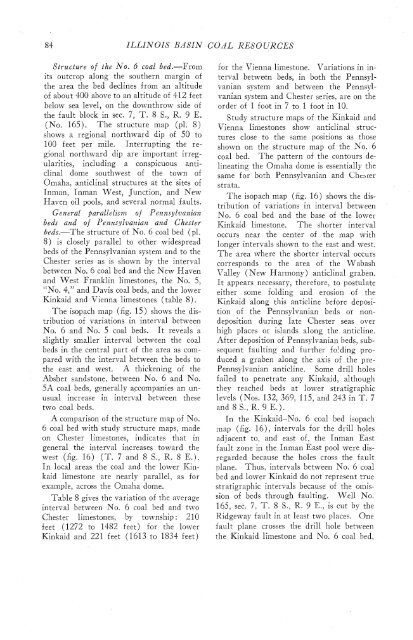subsurface geology and coal resources of the pennsylvanian system ...
subsurface geology and coal resources of the pennsylvanian system ...
subsurface geology and coal resources of the pennsylvanian system ...
Create successful ePaper yourself
Turn your PDF publications into a flip-book with our unique Google optimized e-Paper software.
84 ILLINOIS BASIN COAL RESOURCES<br />
Structure <strong>of</strong> <strong>the</strong> No. 6 <strong>coal</strong> bed.-From<br />
its outcrop along <strong>the</strong> sou<strong>the</strong>rn margin <strong>of</strong><br />
<strong>the</strong> area <strong>the</strong> bed declines from an altitude<br />
<strong>of</strong> about 400 above to an altitude <strong>of</strong> 412 feet<br />
below sea level, on <strong>the</strong> downthrow side <strong>of</strong><br />
<strong>the</strong> fault block in sec. 7, T. 8 S., R. 9 E.<br />
(No. 165). The structure map (pl. 8)<br />
shows a regional northward dip <strong>of</strong> 50 to<br />
100 feet per mile. Interrupting <strong>the</strong> regional<br />
northward dip are important irregularities,<br />
including a conspicuous anticlinal<br />
dome southwest <strong>of</strong> <strong>the</strong> town <strong>of</strong><br />
Omaha, anticlinal structures at <strong>the</strong> sites <strong>of</strong><br />
Inman, Inman West, Junction, <strong>and</strong> New<br />
Haven oil pools, <strong>and</strong> several normal faults.<br />
General parallelisnz <strong>of</strong> Pennsylvanian<br />
beds <strong>and</strong> <strong>of</strong> Pennsylvanian <strong>and</strong> Chester<br />
beds.-The structure <strong>of</strong> No. 6 <strong>coal</strong> bed (pl.<br />
8) is closely parallel to o<strong>the</strong>r widespread<br />
beds <strong>of</strong> <strong>the</strong> Pennsylvanian <strong>system</strong> <strong>and</strong> to <strong>the</strong><br />
Chester series as is shown by <strong>the</strong> interval<br />
between No. 6 <strong>coal</strong> bed <strong>and</strong> <strong>the</strong> New Haven<br />
<strong>and</strong> West Franklin limestones, <strong>the</strong> No. 5,<br />
"No. 4," <strong>and</strong> Davis <strong>coal</strong> beds, <strong>and</strong> <strong>the</strong> lower<br />
Kinkaid <strong>and</strong> Vienna limestones (table 8).<br />
for <strong>the</strong> Vienna limestone. Variations in interval<br />
between beds, in both <strong>the</strong> Pennsylvanian<br />
<strong>system</strong> <strong>and</strong> between <strong>the</strong> Pennsylvanian<br />
<strong>system</strong> <strong>and</strong> ,Chester series, are o,n <strong>the</strong><br />
order <strong>of</strong> 1 foot in 7 to I foot in 10.<br />
Study structure maps <strong>of</strong> <strong>the</strong> Kinkaid <strong>and</strong><br />
Vienna limestones show anticlinal structures<br />
close to <strong>the</strong> same positions as those<br />
shown on <strong>the</strong> structure map <strong>of</strong> <strong>the</strong> No. 6<br />
<strong>coal</strong> bed. The pattern <strong>of</strong> <strong>the</strong> contours delineating<br />
<strong>the</strong> Omaha dome is essentially <strong>the</strong><br />
same for both Pennsylvanian <strong>and</strong> Cheater<br />
strata.<br />
The isopach map (fig. 16) shows <strong>the</strong> distribution<br />
<strong>of</strong> variations in interval between<br />
No. 6 <strong>coal</strong> bed <strong>and</strong> <strong>the</strong> base <strong>of</strong> <strong>the</strong> lower<br />
Kinkaid limestone. The shorter interval<br />
occurs near <strong>the</strong> center <strong>of</strong> <strong>the</strong> map with<br />
longer intervals shown to <strong>the</strong> east <strong>and</strong> west.<br />
The area where <strong>the</strong> shorter interval occurs<br />
corresponds to <strong>the</strong> area <strong>of</strong> <strong>the</strong> Wabash<br />
Valley (New Harmony) anticlinal graben.<br />
It appears necessary, <strong>the</strong>refore, to postulate<br />
ei<strong>the</strong>r some folding <strong>and</strong> erosion <strong>of</strong> <strong>the</strong><br />
Kinkaid along this anticline before deposi-<br />
The isopach map (fig. 15) shows <strong>the</strong> dis- tion <strong>of</strong> <strong>the</strong> Pennsylvanian beds or nontribution<br />
<strong>of</strong> variations in interval between deposition during late Chester seas over<br />
No. 6 <strong>and</strong> No. 5 <strong>coal</strong> beds. It reveals a high places or isl<strong>and</strong>s along <strong>the</strong> anticline.<br />
slightly smaller interval between <strong>the</strong> <strong>coal</strong> After deposition <strong>of</strong> Pennsylvanian beds, subbeds<br />
in <strong>the</strong> central part <strong>of</strong> <strong>the</strong> area as com- sequent faulting <strong>and</strong> fur<strong>the</strong>r folding propared<br />
with <strong>the</strong> interval between <strong>the</strong> beds to duced a graben along <strong>the</strong> axis <strong>of</strong> <strong>the</strong> pre<strong>the</strong><br />
east <strong>and</strong> west. A thickening <strong>of</strong> <strong>the</strong> Pennsylvanian anticline. Some drill holes<br />
Absher s<strong>and</strong>stone, between No. 6 <strong>and</strong> No. failed to penetrate any Kinkaid, although<br />
5A <strong>coal</strong> beds, generally accompanies an un- <strong>the</strong>y reached beds at lower stratigraphic<br />
usual increase in interval between <strong>the</strong>se levels (Nos. 132, 369, 115, <strong>and</strong> 243 in T. 7<br />
two <strong>coal</strong> beds.<br />
<strong>and</strong> 5 S., R. 9 E.).<br />
A co,mparison <strong>of</strong> <strong>the</strong> structure map <strong>of</strong> No. In <strong>the</strong> Kinkaid-No. 6 <strong>coal</strong> bed isopach<br />
6 <strong>coal</strong> bed with study structure maps, made map (fig. 16), intervals for <strong>the</strong> drill holes<br />
on Chester limestones, indicates that in adjacent to, <strong>and</strong> east <strong>of</strong>, <strong>the</strong> Inman East<br />
general <strong>the</strong> interval increases toward <strong>the</strong> fault zone in <strong>the</strong> Inman East pool were diswest<br />
(fig. 16) (T. 7 <strong>and</strong> 8 S., R. 8 E.). regarded because <strong>the</strong> holes cross <strong>the</strong> fault<br />
In local areas <strong>the</strong> <strong>coal</strong> <strong>and</strong> <strong>the</strong> lower Min- plane. Thus, intervals between No. 6 <strong>coal</strong><br />
kaid limestone are nearly parallel, as for bed <strong>and</strong> lower Kinkaid do not represent true<br />
example, across <strong>the</strong> Omaha dome.<br />
stratigraphic intervals because <strong>of</strong> <strong>the</strong> omis-<br />
Table 8 gives <strong>the</strong> variatioa <strong>of</strong> <strong>the</strong> average<br />
interval between No. 6 <strong>coal</strong> bed <strong>and</strong> two<br />
Chester limestones, by township : 21 0<br />
feet (1272 to 1452 feet) for <strong>the</strong> 1o;c~~er<br />
Kinkaid <strong>and</strong> 221 feet (1613 to 1534 feet)<br />
sion <strong>of</strong> beds through faulting. Well No.<br />
165, sec. 7, T. 8 S., K. 9 E., is cut by <strong>the</strong><br />
Ridgeway fault in at least two places. One<br />
fault plane crosses <strong>the</strong> drill hole between<br />
<strong>the</strong> Kinkaid limestone <strong>and</strong> No. 6 <strong>coal</strong> bed,
















